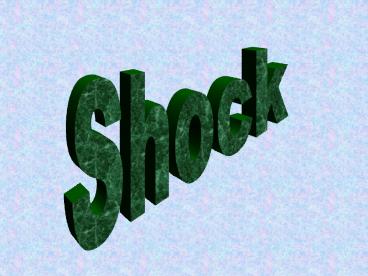Shock PowerPoint PPT Presentation
1 / 29
Title: Shock
1
Shock
2
What is Shock ? ? ?
- Shock is a failure of the circulatory system to
maintain adequate perfusion of vital organs. - cellular hypoxia
- anaerobic cellular metabolism
- accumulation of waste products in cells
- cellular death
3
Types of Shock
- Distributive Shock
- Neurogenic shock
- Septic shock
- Anaphylactic shock
- Hypovolemic Shock
- Cardiogenic Shock
4
Distributive Shock
- Distributive shock occurs as a result of
inadequate vascular tone. - neurogenic shock
- septic shock
- anaphylactic shock
5
Hypovolemic Shock
- Hypovolemic shock occurs when there is a large
reduction in the circulating blood volume. - Actual hypovolemic shock - loss of blood or fluid
- Relative hypovolemic shock - internal fluid
shifts from intravascular to interstitial space.
6
Cardiogenic Shock
- Cardiogenic shock occurs when the heart is unable
to function adequately resulting in insufficient
blood flow to tissue and organs. - myocardial infarction
- obstruction of blood flow
- congestive heart failure
7
Stages of Shock
- Initial Stage
- Compensatory Stage
- Progressive Stage
- Irreversible Stage
8
Stages of Shock
- Initial Stage
- Compensatory Stage
- Progressive Stage
- Irreversible Stage
9
Initial Stage
- Initially, the body compensates with the onset of
shock. - No changes are noted clinically.
- Changes are beginning to occur on the cellular
level.
10
Stages of Shock
- Initial Stage
- Compensatory Stage
- Progressive Stage
- Irreversible Stage
11
Compensatory Stage
- Fluid shift from insterstital to intravascular
space. - Activation of SNS - activation of epinephrine and
norepinephrine. - Kidneys release renin into blood formation
of angiotension release of aldosterone, ADH
12
Decreased CO
SNS stimulation
Renin secreted by kidney
hydrostatic pressure
Epinephrine norepinephrine released
Angiotension
fluid pulled into capillary
Aldosterone
Vasoconstriction
ADH
Increased SVR
Increase blood volume
Blood Pressure Maintained
13
Stages of Shock
- Initial Stage
- Compensatory Stage
- Progressive Stage
- Irreversible Stage
14
Progressive Stage
- Vicious circle of compensation eventually leads
to decompensation. - Blood pressure starts to fall - SBP below 80 is
considered danger signal. - Tachycardia tachypnea decreased urine output
decreased body temperature cold, pale clammy
skin.
15
Stages of Shock
- Initial Stage
- Compensatory Stage
- Progressive Stage
- Irreversible Stage
16
Irreversible Stage
- Body attempts at compensation have failed - death
is imminent. - Pooling and sludging of blood thrombosis of
small vessels occurs. - Tissue hypoxia and anoxia occur - lactic acid
accumulation contributes to cell death.
17
Management of Shock
- Treat underlying cause.
- Knowing the cause of the shock is necessary to
treat the shock.
18
Management of Shock
- Oxygenation
- In all types of shock, supplemental oxygen is
administered to protect against hypoxemia.
19
Management of Shock
- Positioning
- the recommended position for the patient in
shock is supine with legs elevated 45 degrees.
20
Management of Shock
- Replacing Fluid Volume
- The primary goal of shock therapy is to increase
the circulating blood volume. - crystalloids
- colloids
- Fluid replacement should be based on central
venous pressures or pulmonary artery pressures
and cardiac output.
21
Management of Shock
- Pharmacologic Agents
- Vasoconstrictors
- Dopamine
- Norepinephrine
- Vasodilators
- Nitroprusside
- Nitroglycerin
- Sympathomimetics
- Epinephrine
- Corticosteriods
- Decadron
- Solumedrol
- Appropriate antidotes or antibiotics
22
Complications of Shock
- Metabolic Acidosis
- Acute Tubular Necrosis
- DIC
- ARDS
- SIRS MOSF
23
SIRS Multi-Organ System Failure
- May occur in patient who has survived a shock
episode. - Commonly associated with septic shock, especially
gram negative septic shock
24
Systemic Inflammatory Response Syndrome
- Causes damage to organs and tissues by
- damaging vascular endothelial cells
- hypermetabolism
- maldistribution of blood flow to organs
- organ hypoperfusion
25
New Priorities in Septic Shock Care
- Multiple multi national research projects
- 4 new findings, care priorities
- 1. Use of activated protein C (Xigris)- new IV
medication for septic shock - expensive but effective
- 2. Use of high dose steroids
- test for reactiveness, then individualized dosing
- 3. Intensive insulin therapy
- tight glucose control (
- 4. Aggressive fluid therapy, monitoring
26
Shock Recap
- Types of Shock
- Distributive Shock
- Neurogenic shock
- Septic shock
- Anaphylactic shock
- Hypovolemic Shock
- Cardiogenic Shock
27
Recap
- Stages of Shock
- Initial Stage
- Compensatory Stage
- Progressive Stage
- Irreversible Stage
28
Recap..
- Treatment of Shock
- O2,O2,O2, did I say oxygen?
- Positioning
- Fluids
- Colloids
- Crystalloids
- Pharmacological agents
29
Cutting Edge Therapies
- Use of Xigris
- Use of steroids
- Intensive insulin therapy
- Aggressive fluid resuscitation/ monitoring

